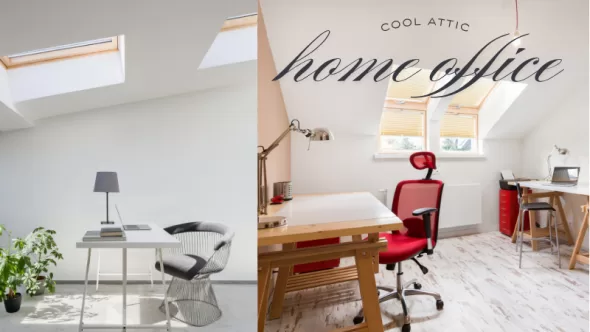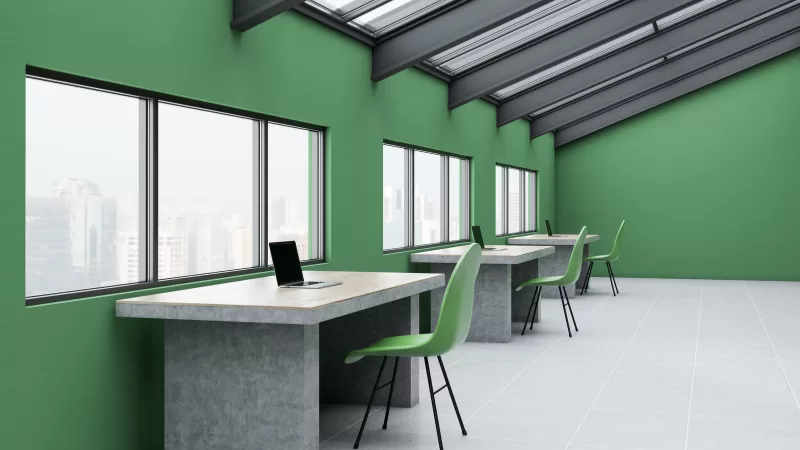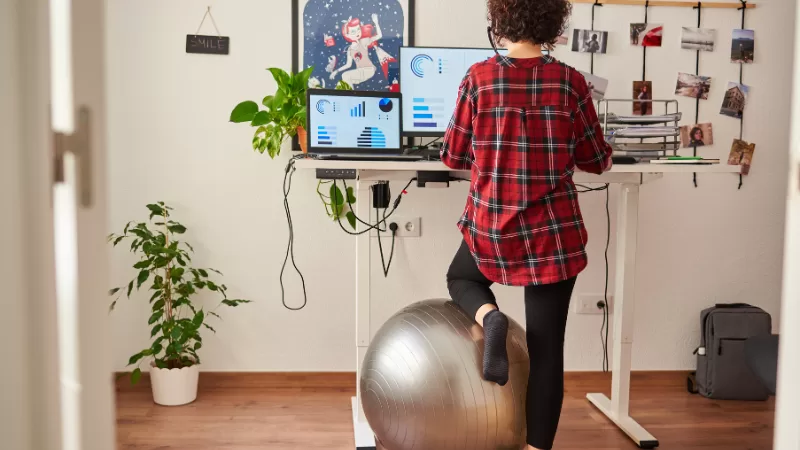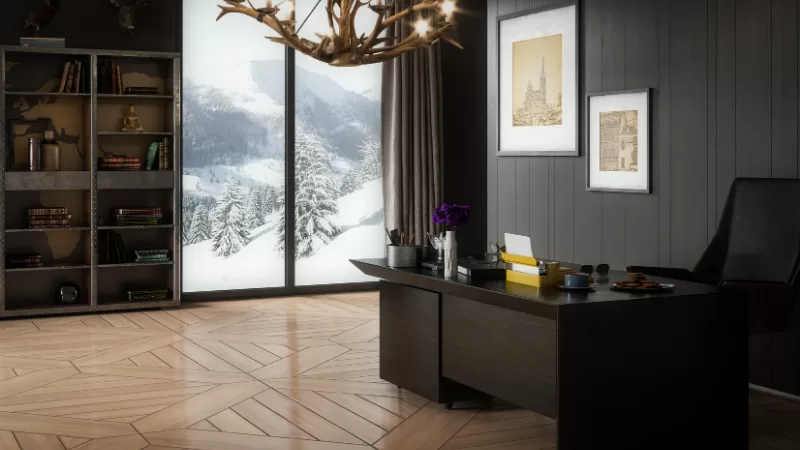Picture this: You’re scrolling through TikTok during your lunch break, dreaming of escaping that cramped corner desk in your bedroom that doubles as your “home office.” Meanwhile, there’s this entire unused space above your head just collecting dust and old Christmas decorations. Girl, it’s time to level up! Your attic isn’t just storage anymore – it’s about to become the most fire workspace that’ll have everyone asking where you got that aesthetic setup. Whether you’re a remote worker, side hustler, or creative entrepreneur, transforming your attic into a home office is the glow-up your productivity (and your Instagram feed) desperately needs.
Why Your Attic is Actually Perfect for a Home Office
The Privacy You’ve Been Craving
Let’s be real – working from home can be chaotic. Between family members, roommates, and that neighbor who thinks 7 AM is the perfect time for lawn mowing, finding peace can feel impossible. An attic office gives you that separation you need to actually focus and be productive.

Your attic naturally provides:
- Sound isolation from household noise and distractions
- Physical separation from high-traffic areas
- Dedicated workspace that you don’t have to pack up every day
- Professional video call backdrop (because nobody needs to see your unmade bed)
Maximize Your Home’s Square Footage
Most attics have way more usable space than people realize. Even with sloped ceilings and unique angles, you can create a functional workspace that makes every square foot count. This is especially valuable in today’s housing market where extra space equals extra value.
Natural Light and Views
Many attics come with skylights or interesting windows that offer amazing natural light and unique views. Imagine taking your video calls with beautiful natural lighting streaming in from above – it’s like having a built-in ring light!
25+ Creative Attic Home Office Ideas to Inspire Your Transformation
1. Modern Minimalist Haven

Create a clean, clutter-free workspace with:
- White or light-colored walls to maximize brightness
- Floating desk attached to the wall to save floor space
- Built-in storage solutions that follow the roofline
- Ergonomic chair in a pop of color for personality
- Smart lighting with adjustable brightness for different tasks
2. Cozy Cabin Vibes with Exposed Beams

Embrace those architectural features:
- Exposed wooden beams painted or stained for character
- Rustic wood desk made from reclaimed materials
- Warm lighting with pendant lamps or string lights
- Natural textures like woven baskets and wool rugs
- Plants to bring life into the space
3. Industrial Chic Workspace

For that modern, edgy aesthetic:
- Metal desk with clean lines
- Industrial lighting with exposed bulbs
- Concrete or metal accents for texture
- Black and white color scheme with metallic touches
- Rolling storage carts for flexibility
4. Bohemian Creative Studio

Perfect for artists and creative professionals:
- Colorful tapestries or artwork on the walls
- Floor cushions and low seating for relaxed work
- Macrame plant hangers for vertical greenery
- Vintage furniture pieces with character
- Gallery wall showcasing your favorite pieces
5. Tech-Forward Smart Office

Integrate the latest technology:
- Smart desk with height adjustment and built-in charging
- Multiple monitor setup for maximum productivity
- Voice-controlled lighting and temperature systems
- Wireless charging stations built into the desk
- Cable management systems for a clean look
6. Scandinavian-Inspired Retreat

Clean, functional, and beautiful:
- Light wood furniture with simple lines
- Neutral color palette of whites, grays, and soft blues
- Hygge elements like cozy throws and candles
- Functional storage that doubles as decoration
- Natural materials throughout the space
7. Flex Space Office-Guest Room Combo

Make your space work double duty:
- Murphy bed or daybed that can serve as seating
- Foldable desk that can be stored away
- Dual-purpose furniture like storage ottomans
- Room dividers to separate work and sleep areas
- Guest amenities like extra lighting and storage
8. Athletic Workspace with Standing Options

For the health-conscious remote worker:
- Standing desk converter for posture variety
- Balance board or under-desk bike for movement
- Yoga space with mats and props nearby
- Air purifier and humidifier for optimal air quality
- Motivational artwork and fitness tracking displays
9. Creative Maker Space

Perfect for designers, writers, and creators:
- Large work surface for projects and sketching
- Inspiration board or mood board wall
- Art supply storage with easy access
- Good task lighting for detailed work
- Comfortable seating for long creative sessions
10. Luxury Executive Suite

Create a high-end professional atmosphere:
- High-quality wooden desk with executive styling
- Leather chair for comfort and sophistication
- Built-in bookshelf for displaying credentials and books
- Professional lighting including desk lamps and ambient options
- Meeting area with additional seating for video calls
Essential Design Considerations for Attic Offices
Working with Sloped Ceilings
Sloped ceilings are often seen as a challenge, but they can actually add character to your workspace:
Low Ceiling Areas:
- Use for storage solutions like built-in cabinets
- Create cozy reading nooks with floor seating
- Install under-eave storage for office supplies
- Consider floor-level workstations for specific tasks
High Ceiling Areas:
- Position your main desk in the highest area
- Use for standing work or presentation areas
- Install ceiling-mounted storage or lighting
- Create vertical storage solutions
Maximizing Natural Light
Natural light is crucial for productivity and mood:
Skylight Optimization:
- Position your desk near skylights when possible
- Use light-colored surfaces to reflect more light
- Install skylight blinds for glare control
- Consider solar tubes if additional light is needed
Window Treatments:
- Choose sheer curtains or adjustable blinds
- Use mirrors strategically to bounce light around
- Paint walls in light, reflective colors
- Avoid heavy or dark window treatments
Climate Control and Comfort
Attics can be challenging temperature-wise, but proper planning makes them comfortable year-round:
Insulation Improvements:
- Upgrade insulation before starting your renovation
- Seal air leaks around windows and roof penetrations
- Consider radiant barrier installation for hot climates
- Insulate ductwork if running HVAC to the space
Heating and Cooling Solutions:
- Mini-split systems offer efficient, targeted climate control
- Ceiling fans help with air circulation
- Space heaters for supplemental winter heating
- Dehumidifiers in humid climates
Electrical and Technology Infrastructure
Plan your power and connectivity needs carefully:
Electrical Requirements:
- Dedicated circuits for high-power equipment
- Plenty of outlets placed strategically around the workspace
- USB charging outlets for convenience
- Proper lighting circuits with dimmer controls
Internet and Connectivity:
- Hardwired ethernet for the most reliable connection
- WiFi extender or mesh system if needed
- Cable management to keep things organized
- Backup power solutions for important equipment
Storage Solutions That Work in Attic Offices
Built-in Storage Ideas
Custom storage makes the most of awkward spaces:
Under-Eave Storage:
- Pull-out drawers that fit perfectly under slopes
- Built-in filing cabinets for important documents
- Supply storage with easy-access bins and baskets
- Seasonal item storage for things you don’t use daily
Vertical Storage Systems:
- Floor-to-ceiling shelving on full-height walls
- Wall-mounted cabinets that don’t take floor space
- Pegboard systems for tools and supplies
- Floating shelves for books and decorative items
Flexible Storage Options
For renters or those who want flexibility:
Mobile Storage:
- Rolling carts that can move where needed
- Storage ottomans that provide seating and storage
- Under-desk filing cabinets on wheels
- Portable shelving units that can be reconfigured
Multi-functional Furniture:
- Desk with built-in storage drawers and compartments
- Storage bench for seating and hiding supplies
- Bookshelf room dividers to separate spaces
- Trunk or chest for large item storage
Lighting Design for Productivity
Layer Your Lighting
Good lighting combines multiple sources:
Ambient Lighting:
- Overhead fixtures for general illumination
- Recessed lights for even coverage
- Track lighting for flexibility
- Natural light from windows and skylights
Task Lighting:
- Desk lamps for focused work
- Under-cabinet lighting for keyboard and paperwork
- Reading lights for comfortable document review
- Adjustable spotlights for specific tasks
Accent Lighting:
- Wall sconces for ambient mood
- String lights for cozy atmosphere
- LED strip lighting behind monitors or under shelves
- Table lamps for warm, personal lighting
Technology Integration
Modern lighting should be smart and efficient:
Smart Controls:
- Dimmer switches for adjustable brightness
- Smart bulbs that change color temperature
- Motion sensors for automatic operation
- Timer controls for consistent daily rhythms
Energy Efficiency:
- LED bulbs for long life and low energy use
- Natural light optimization to reduce electric needs
- Task-specific lighting to avoid over-illuminating
- Energy Star rated fixtures for efficiency
Creating the Perfect Work Environment
Ergonomics and Health
Your body will thank you for proper ergonomic setup:
Desk Setup:
- Monitor at eye level to prevent neck strain
- Keyboard and mouse at proper height
- Foot rest if needed for proper leg position
- Document holder to reduce neck movement
Seating Solutions:
- Ergonomic chair with proper lumbar support
- Adjustable height for perfect desk alignment
- Armrest support for shoulders and arms
- Movement options like balance balls or standing desk
Air Quality and Health
Attic spaces need extra attention to air quality:
Ventilation:
- Exhaust fans to remove stale air
- Cross-ventilation when possible with multiple openings
- Air circulation with ceiling fans or desk fans
- Fresh air intake through operable windows
Air Quality Improvements:
- Air purifier for clean breathing
- Plants that naturally filter air
- Humidity control with humidifiers or dehumidifiers
- Low-VOC materials for furniture and finishes
Noise Control
Create a quiet, focused environment:
Sound Absorption:
- Carpet or rugs to reduce footstep noise
- Curtains or fabric panels to absorb sound
- Upholstered furniture for sound dampening
- Acoustic panels for serious noise control
Noise Isolation:
- Insulation in walls and ceiling for sound blocking
- Solid doors with weather stripping
- White noise machines to mask distracting sounds
- Soft furnishings to reduce echo and reverberation
Budgeting for Your Attic Office Transformation
DIY vs Professional Work
Decide what you can handle yourself:
DIY-Friendly Projects:
- Painting walls and ceiling
- Installing floating shelves and simple storage
- Decorating and furnishing the space
- Basic electrical like installing new outlets (with permits)
Professional Work:
- Structural modifications like dormers or stairs
- Major electrical work requiring new circuits
- HVAC installation for climate control
- Insulation upgrades requiring wall or roof access
Cost-Saving Strategies
Maximize your budget with smart choices:
Furniture and Furnishing:
- Shop second-hand for desks and storage
- DIY projects for custom storage solutions
- Multi-purpose furniture that serves multiple needs
- Gradual purchasing to spread costs over time
Materials and Finishes:
- Paint instead of expensive wall treatments
- Laminate flooring instead of hardwood
- DIY window treatments instead of custom options
- Mix high and low price points strategically
Realistic Budget Ranges
Plan for these typical cost ranges:
Basic Refresh ($1,000-$3,000):
- Paint and basic lighting improvements
- Used furniture and simple storage solutions
- DIY decorating and minor repairs
- Basic comfort improvements like fans or space heaters
Mid-Range Renovation ($3,000-$8,000):
- New flooring and professional painting
- Built-in storage and custom solutions
- Electrical upgrades and improved lighting
- Climate control additions
High-End Transformation ($8,000-$20,000+):
- Structural modifications and professional design
- Custom built-ins and high-end finishes
- Full HVAC installation and smart home integration
- Professional furniture and complete renovation
Seasonal Considerations and Maintenance
Winter Warmth
Keep your attic office comfortable in cold weather:
Heating Solutions:
- Space heaters for targeted warmth
- Radiant floor heating for comfortable feet
- Insulated window treatments to retain heat
- Weather stripping around doors and windows
Moisture Control:
- Ventilation fans to prevent condensation
- Dehumidifiers in humid climates
- Vapor barriers properly installed
- Regular inspection for ice dams or leaks
Summer Cooling
Beat the heat in your upper-level office:
Cooling Strategies:
- Ceiling fans for air circulation
- Window treatments to block solar heat
- Ventilation to remove hot air
- Insulation to prevent heat transfer
Heat Reduction:
- Reflective roof coatings to reduce heat absorption
- Ridge vents for hot air escape
- Solar screens on windows
- Light-colored finishes that don’t absorb heat
Year-Round Maintenance
Keep your attic office in top condition:
Regular Inspections:
- Roof leaks and water damage checks
- Pest control and insect prevention
- Air quality monitoring and filter changes
- Electrical systems and safety equipment testing
Seasonal Tasks:
- Cleaning and decluttering regularly
- HVAC maintenance and filter replacement
- Window cleaning for maximum natural light
- Equipment maintenance and technology updates
Technology Setup for Maximum Productivity
Internet and Connectivity
Ensure reliable internet for your attic office:
Wired Connections:
- Ethernet cable run to your desk area
- Cable management to keep things tidy
- Network switch if you need multiple connections
- Backup connection options for redundancy
Wireless Solutions:
- WiFi mesh system for strong signal throughout
- WiFi extender specifically placed for attic coverage
- Mobile hotspot as backup internet
- Signal boosters if cell service is weak
Power and Electrical Setup
Plan for all your electrical needs:
Outlet Placement:
- Desk level outlets for easy access
- Floor outlets for center-of-room equipment
- USB charging outlets for devices
- Dedicated circuits for high-power equipment
Power Protection:
- Surge protectors for sensitive electronics
- UPS systems for critical equipment
- GFCI outlets in areas with potential moisture
- Arc fault breakers for fire protection
Equipment and Setup
Choose the right technology for your needs:
Computer Setup:
- Dual monitor configuration for productivity
- Laptop docking station for easy connection
- Wireless keyboard and mouse for flexibility
- Webcam and microphone for video calls
Storage and Backup:
- Cloud storage for automatic backup
- External hard drives for local backup
- Network attached storage for family sharing
- Document management systems for organization
Inspiring Real-World Examples
The Creative Freelancer’s Dream
Sarah, a graphic designer, transformed her 400-square-foot attic into a bright, inspiring workspace:
Key Features:
- Large skylights provide amazing natural light
- White painted beams keep the space feeling open
- Custom desk built to fit perfectly under the slope
- Inspiration wall with rotating client work and mood boards
- Comfortable seating area for client meetings via video call
Budget: $5,500 including built-in desk and storage
The Tech Entrepreneur’s Command Center
Mike converted his attic into a high-tech office for his startup:
Key Features:
- Multiple monitor setup for development work
- Standing desk converter for health
- Smart lighting that adjusts throughout the day
- Video conferencing setup with professional lighting
- Climate control with a mini-split system
Budget: $12,000 including all technology and HVAC
The Writer’s Cozy Retreat
Emma created a peaceful writing space in her small attic:
Key Features:
- Reading nook with built-in seating and storage
- Simple floating desk that doesn’t overwhelm the space
- Warm lighting with multiple table lamps
- Built-in bookshelves for research materials
- Sound dampening with rugs and curtains
Budget: $2,800 with mostly DIY work
Safety Considerations
Structural Safety
Ensure your attic can safely support office use:
Load Capacity:
- Professional assessment of floor joists and support
- Weight distribution of heavy furniture and equipment
- Reinforcement if needed for additional load
- Building codes compliance for office use
Access Safety:
- Proper stairs or sturdy ladder access
- Adequate headroom in travel areas
- Emergency egress planning and compliance
- Handrails and lighting for safe navigation
Fire Safety
Protect yourself and your investment:
Detection and Alarm:
- Smoke detectors with battery backup
- Carbon monoxide detectors if fuel-burning appliances present
- Heat detectors in areas where smoke detectors aren’t suitable
- Interconnected alarms that alert throughout the house
Fire Prevention:
- Proper electrical installation to code standards
- Heat management for electronics and lighting
- Clear egress paths kept free of storage
- Fire extinguisher appropriate for electrical fires
Health and Safety
Create a healthy work environment:
Air Quality:
- Ventilation for fresh air circulation
- Humidity control to prevent mold growth
- Air filtration for clean breathing
- Regular inspection for water leaks or pest issues
Ergonomic Safety:
- Proper lighting to prevent eye strain
- Ergonomic furniture to prevent repetitive stress
- Movement breaks encouraged by space layout
- Temperature control for comfort and focus
Making It Happen: Your Action Plan
Phase 1: Planning and Assessment (Weeks 1-2)
Evaluate Your Space:
- Measure dimensions and note architectural features
- Assess structural condition and identify needed repairs
- Check electrical and HVAC systems
- Research building codes and permit requirements
Define Your Vision:
- Create a mood board with inspiring images
- List functional requirements for your work
- Set a realistic budget with contingency funds
- Plan timeline with major milestones
Phase 2: Infrastructure (Weeks 3-6)
Structural Work:
- Complete necessary repairs like roof leaks or floor issues
- Install or upgrade electrical systems
- Add or improve insulation for comfort
- Install HVAC or climate control solutions
Safety and Code Compliance:
- Install smoke and carbon monoxide detectors
- Ensure proper egress and emergency access
- Complete electrical work to code standards
- Schedule required inspections
Phase 3: Finishing and Furnishing (Weeks 7-10)
Finishes:
- Paint walls and ceiling in chosen colors
- Install flooring if replacing existing
- Add window treatments for light and privacy control
- Install lighting fixtures and electrical devices
Furniture and Setup:
- Install built-in storage and custom elements
- Place furniture according to your layout plan
- Set up technology and test all systems
- Add personal touches and decorative elements
Phase 4: Optimization and Enjoyment (Ongoing)
Fine-tuning:
- Adjust lighting and climate control for comfort
- Organize storage systems for maximum efficiency
- Optimize workflow based on actual use patterns
- Make seasonal adjustments as needed
Ongoing Maintenance:
- Regular cleaning and organization
- Equipment maintenance and software updates
- Seasonal inspections for safety and comfort
- Continuous improvement based on changing needs
Conclusion: Your Dream Attic Office Awaits
Transforming your attic into a productive, beautiful home office isn’t just about creating workspace – it’s about designing a environment that inspires you to do your best work every day. Whether you’re drawn to minimalist Scandinavian design, cozy rustic vibes, or high-tech smart office features, your attic has the potential to become the most functional and appealing room in your house.
The key to success is thoughtful planning that balances your aesthetic vision with practical needs like comfort, safety, and functionality. Start with the basics – ensuring your attic is structurally sound, properly insulated, and safely accessible – then let your creativity guide the design process.
Remember that this transformation doesn’t have to happen overnight. You can phase your renovation to spread costs over time and allow you to live with and refine your design as you go. The most important step is simply starting the process and committing to creating the workspace you deserve.
Your attic office isn’t just a place to work – it’s an investment in your productivity, your comfort, and your home’s value. With the right approach, that forgotten space above your head can become the foundation for your most successful and satisfying work-from-home experience yet.
So grab your measuring tape, start that Pinterest board, and get ready to transform your attic into the ultimate home office that’ll have everyone asking, “How did you even think of this?” Your future self (and your productivity) will thank you for taking this exciting step toward creating a workspace that truly works for you.

